The "bird's eye" view of our trip includes one photo from each of our excursions. Much more information is contained in the individual days.
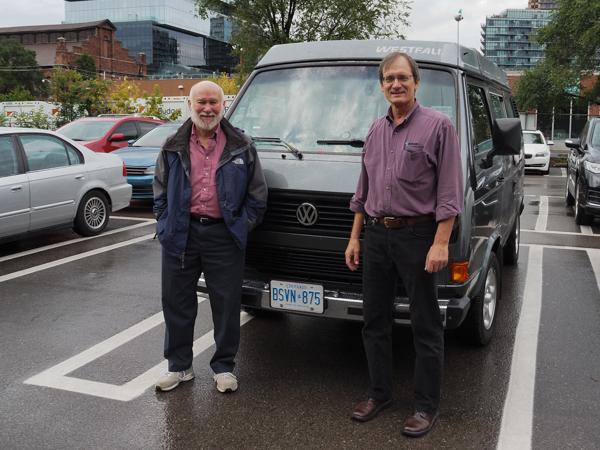
Our excursion started in Toronto, Canada, and our flight from Charlottesville delivered us early in the day. It was an excellent opportunity to connect with long-time friend Paul Honis who now lives in the Toronto area. Our plans to have lunch together were derailed by a malfunctioning alternator on his VW Van, but we were able to coordinate some time and touring together.
It was great to see Paul again and learn about his civic and musical endeavors.
That evening we met up with our fellow Road Scholars for the start of our program.
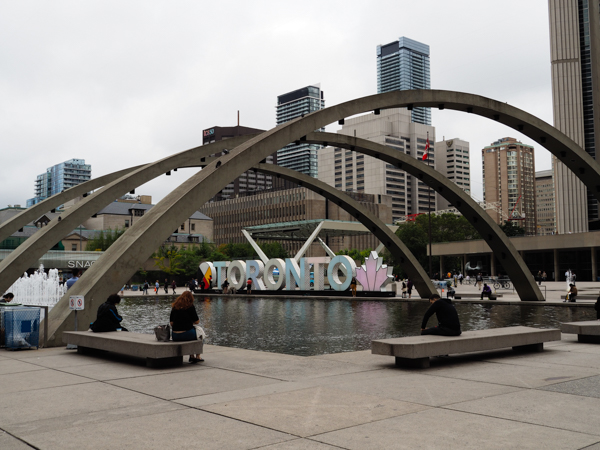
Our hotel was across the street from the City Hall Plaza.
This really is the public square of the city. During the two days we were there, we saw or heard a concert, a march supporting Tamils in Sri Lanka, and a group promoting Falun Gong.
Our first presenter described how multi-cultural Toronto is. Each ethnic group stages a celebration of their heritage and this plaza is a favored location for the various festivals.
Similar open spaces in a city may be sterile and boring. Not in Toronto!

The Royal Ontario Museum has extensive collections of fine art, ethnic history, and natural history.
This particular fossil, a Parasaurolophus walkeri with its distinctive large crest was found in Canada and was one of the most complete of its kind.
Pieces of the displayed skeleton, including the head, are casts. The originals are in special storage for research access.
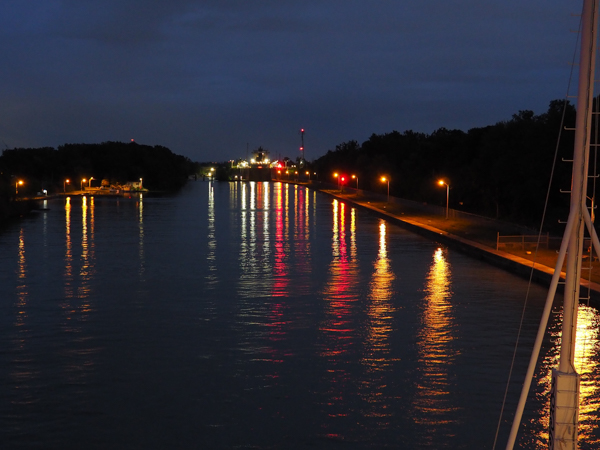
We expected to leave Toronto at 7:00, but were surprised to leave around 5:30 as soon as the last person was on board. The staff person I asked about the change said the ship was trying to reach the first lock of the Welland Canal before a large laker. We didn't, and had to tie up alongside and wait for a bit.
The Welland Canal bypasses Niagara Falls to connect Lakes Ontario and Erie. The current iteration of the canal, the fourth, was completed in the 1930s. As engineering junkies, we had hoped to see more of the canal in daylight, but at least it wasn't pitch black for the first lock -- even though we were behind the larger ship.
The canal doesn't work on a "reservation system" like the Danube canal. It is more-or-less first-come-first-served except that commercial ships trump pleasure craft such as ours.
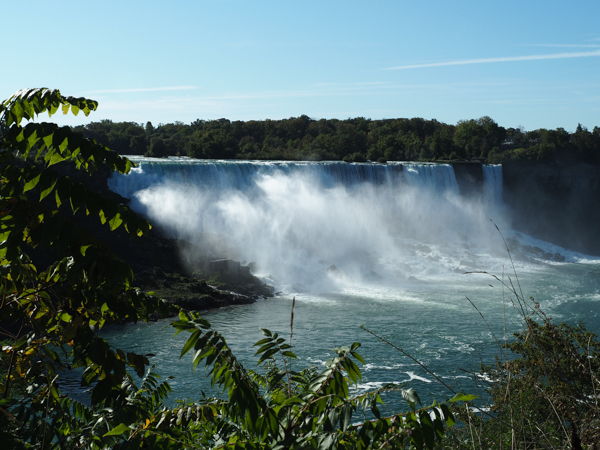
During the night we passed the eight locks of the canal and woke up in Port Colborne, Ontario. We loaded into buses for the drive back across the Niagara Peninsula to the falls.
There are three main falls. The American Falls are shown here with the small Bridal Veil Falls to the right. We anticipated an excursion to the base of the Canadian Horseshoe Falls, which are much bigger.
Diversions for hydro-electric power have diminished the flow over the falls. What we see here is about one-half the natural flow. This is diminished overnight when even more water is diverted.
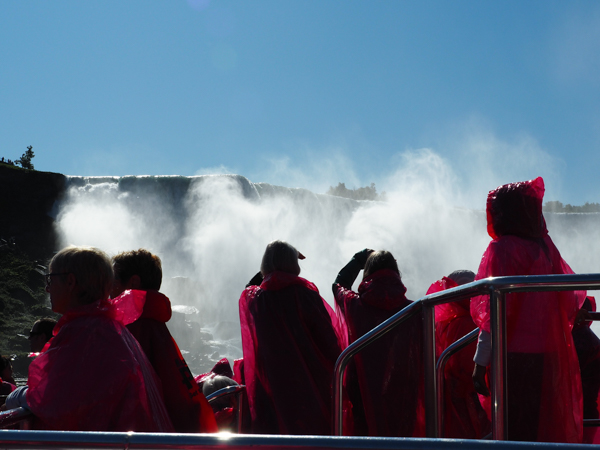
We reached the river's edge on a funicular and then received red ponchos for the excursion to the base of the falls. The ponchos kept us dry-er, but not dry by any stretch.
When I was a child, I visited the falls with my parents. We rode on the Maid of the Mist to the falls. I don't recall much except the yellow rain suits we were issued.
Maid of the Mist still runs the concession on the US side of the falls, but the Canadian concession is now run by Hornblower.
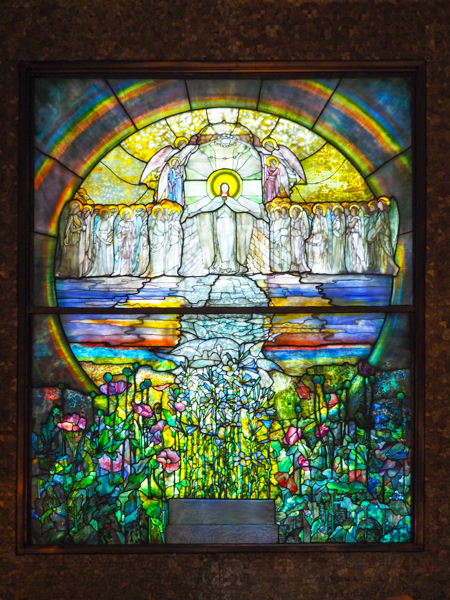
Overnight we traversed much of Lake Erie to arrive at Cleveland, Ohio. We have visited many foreign countries as part of cruises, but this was the first time in many years that we had entered the United States on a ship. It was complicated!
Nevertheless we finally made it through all the hoops and were able to visit Cleveland.
We had no idea of the many beautiful and interesting things to see there.
Our day started with a trolley tour of the city with a stop at the Tiffany Studios-designed Wade Chapel. The centerpiece is this window, but the glass tile mosaics were also striking.
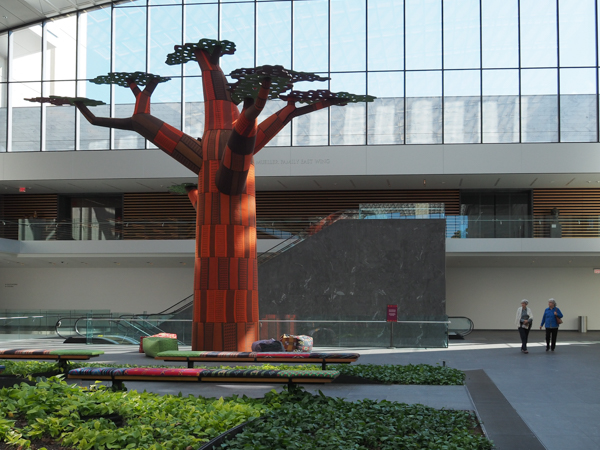
Our next stop was the Cleveland Museum of Art. This structure has a happier marriage of modern and traditional in the expansion of the gallery than the Royal Ontario Museum in Toronto.
The atrium featured an exhibit called "Ámà: The Gathering Place." Emeka Ogboh assembled a variety of places to sit, beautiful Nigerian music, and this massive tree. The pillows, benches, and the tree itself are covered in akwétè cloth. I could have remained here the rest of the day.
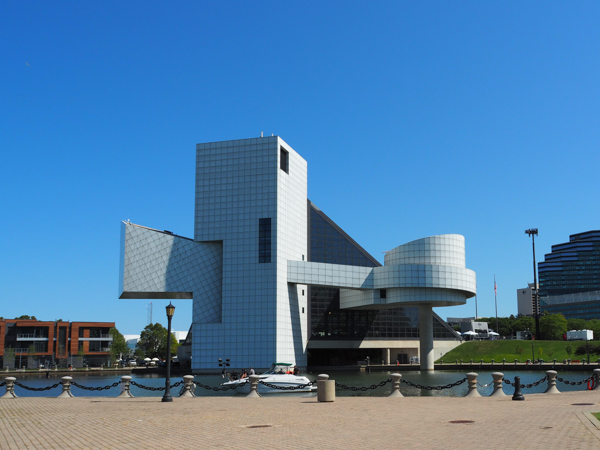
For the afternoon we had tickets to the Rock and Roll Hall of Fame, within walking distance of our ship. The exhibits were fine, but the building, designed by I.M. Pei, was extraordinary.
The story goes that Pei initially refused the commission because he didn't like rock music. It wasn't until he was dragged, more or less, to hear some of the music that he caught the energy and agreed to the design.
That evening we had a lecture on recognizing and identifying ships on the Great Lakes. We were introduced to the website boatnerd.com, which contains all you ever wanted to know, and much more, about Great Lakes ships and shipping. For the rest of the voyage we kept a log of ships sighted. You'll see some in the detailed pages.
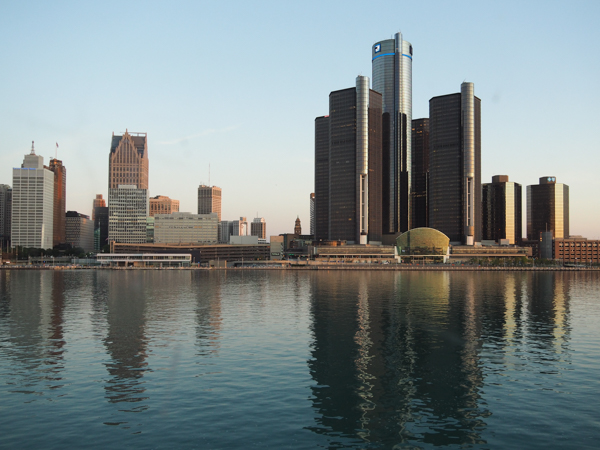
We cruised into Detroit in the early morning sunshine. Our ship docked at the base of the Renaissance Center. We didn't spend much time in Detroit proper but our guide told us both of the depths to which the city had sunk, reaching its nadir in 2013, and the amount to which it has rebounded in the years since.
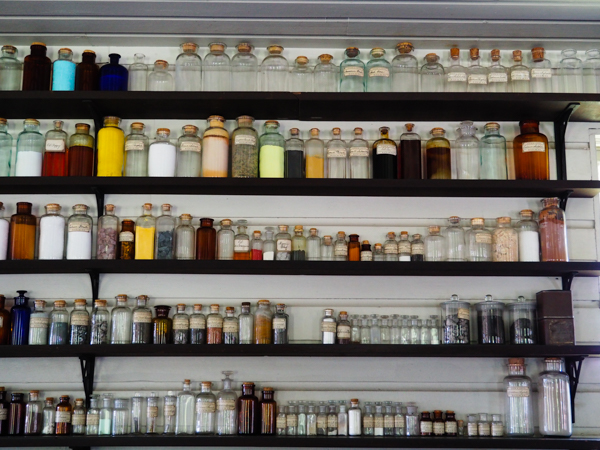
Our primary destination was the Henry Ford Museum in Dearborn, just outside Detroit. Greenfield Village, an outdoor living history museum, offers many historical exhibits including a narrated steam train tour, Thomas Edison's Laboratory and the Wright Brothers Bike shop. Most of the exhibits have either been recreated here or transported from elsewhere.
This array of chemicals was on display in a recreation of Thomas Edison's workshop. As a "professional inventor" he believed that he needed every possible resource -- just in case.
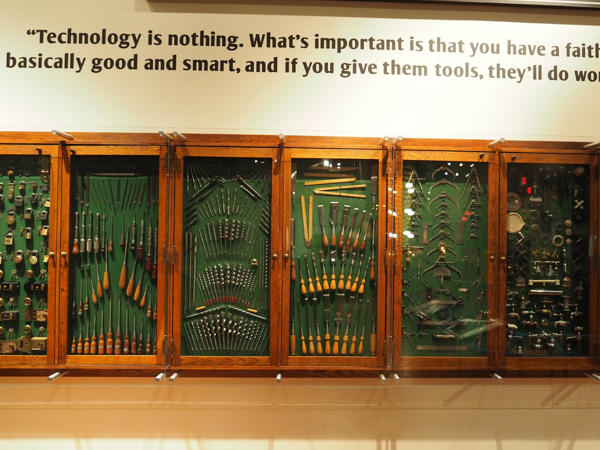
The adjacent museum documents not only the achievements of Henry Ford himself but "the genius of the American people." There are many sections featuring the products of technology.
This particular display of tools was from a hardware store serving a large clientele that didn't speak English. Customers pointed to the specific tool needed and staff fetched it.
The appropriate quote above the display is from Steve Jobs: "Technology is nothing. What's important is that you have a faith in people, that they're basically good and smart, and if you give them tools, they'll do wonderful things with them."
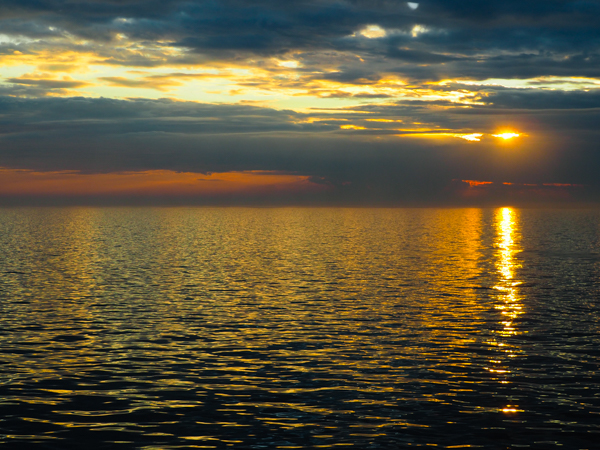
Our next day we were scheduled to cruise Lake Huron to Georgian Bay and our stop at Little Current, Manitoulin Island. The highlight, we thought, was to be a pair of lectures on Great Lakes history by Fred Stonehouse, a noted historian. We had also signed up for a tour of the bridge.
The surprise of the day, however, was the afternoon announcement that one of the ship's engines had failed and that we would have to forgo our stop at Manitoulin Island. Moreover we would be unable to transit the Soo Locks so there went our nudge into Lake Superior.
Oh well.
The captain called a special meeting to give us the bad news and shared "Plan B:" extra time in Sault Ste. Marie to repair the engine.
The glum mood of the evening was lifted by a lovely sunset.
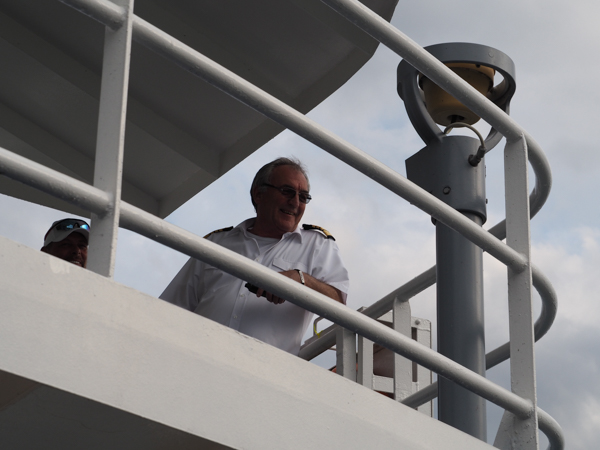
By the next morning we were on Plan C. Sault Ste. Marie would not allow our compromised ship to dock without a large payment for a special tug, so the ship diverted to Mackinac Island for repairs.
Fred and others gave extra lectures and the staff came up with a variety of diverting games.
As the ship arrived at Mackinac, the captain and pilot paid even closer attention than usual to our docking process without full use of the thrusters. No tug required.
The necessary parts had already arrived and repairs started immediately on our busted engine. Those who wished could go ashore to get a head start on exploring Mackinac, but I don't know if anyone did.
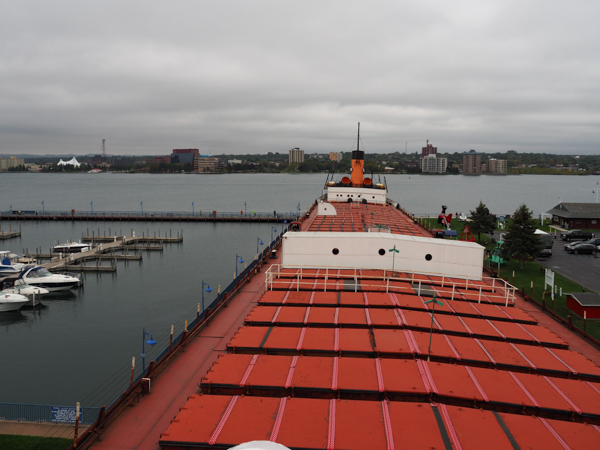
Our intrepid tour leaders and their support staff arranged for buses to pick us up for the planned excursion to Sault Ste. Marie. We would enjoy all of our activities at that location (except the passage of the locks, of course). Although we visited the Soo Locks, we didn't get to see any ships there.
The high point was our visit to the Valley Camp museum of Great Lakes Shipping. There were very many exhibits, but I ducked away from the tour to prowl around the deck. This is what the pilot would see when one of these ships was underway.
This ship at 550' is much smaller than the current generation of 1000+ foot ships now plying the Lakes. I find it hard to imagine the skill it takes to steer and dock one of those monsters.
(This ship is listing. For a change it isn't my habitually crooked stance.)
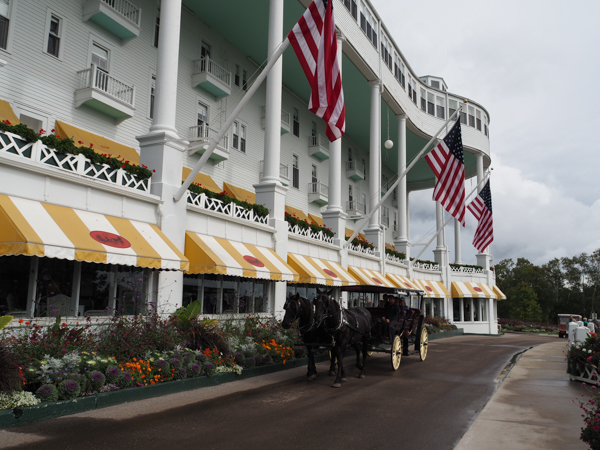
The Straits of Mackinac connect Lake Michigan to Lake Huron. Other than walking, the only mode of transportation allowed on the island is horse-drawn carriage. We toured the island in carriages and had lunch at the Grand Hotel, a National Historic Landmark and one of the most romantic vestiges of the Victorian era. It opened in 1887 as a summer retreat for vacationers and boasts the longest porch in the world.
Lunch was delicious.
After returning to the ship, I checked email to discover that Road Scholar, to make up for our missed excursion, is giving each of us a $150 refund plus a $150 credit on future travel. Nice!
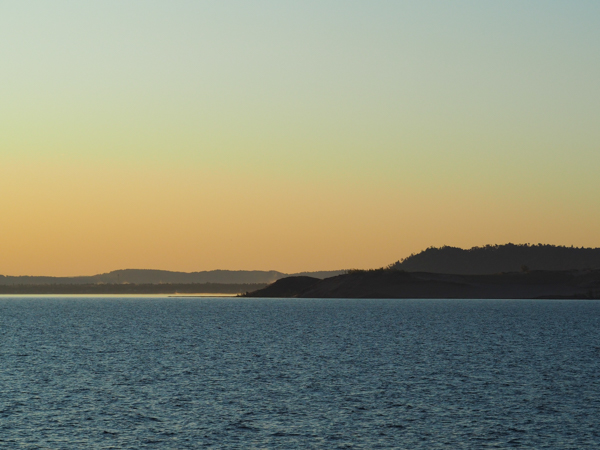
The engineering crew had made good use of our time at Mackinac Island to replace the failing engine part and obtain Coast Guard approval for us to continue on our itinerary. By dawn the next morning we were cruising along the Michigan dunes. We passed these dunes for most of the day.
As we left the relative shelter of the shore in the afternoon, the increasing winds raised choppy whitecaps. The ship never shivered. Throughout the cruise I did not have to reach for my "patch."
The winds, however, forced another change to our planned itinerary. We were supposed to dock in downtown Chicago at the Navy Pier, but the captain decided to divert to Calumet Harbor southeast of the city on the Indiana border.
We were glad to know that safety was a key concern in such decisions, but dismayed at the potential difficulties of getting to our hotel from such a remote location. Not to worry.... Even though we did not dock at the expected location, Road Scholar arranged for a bus to take the handful of independent travellers to the Navy Pier where we could catch cabs.
You may continue our adventures, on the page describing our independent travel in Chicago and North Carolina.
Click your "back" button to return to the previous page or click for our picture album.